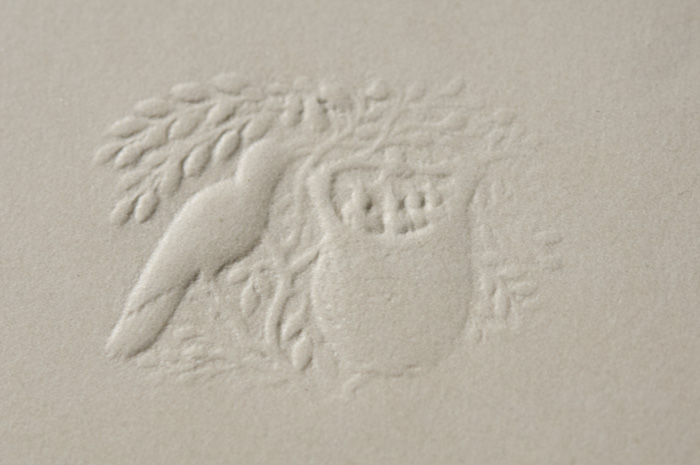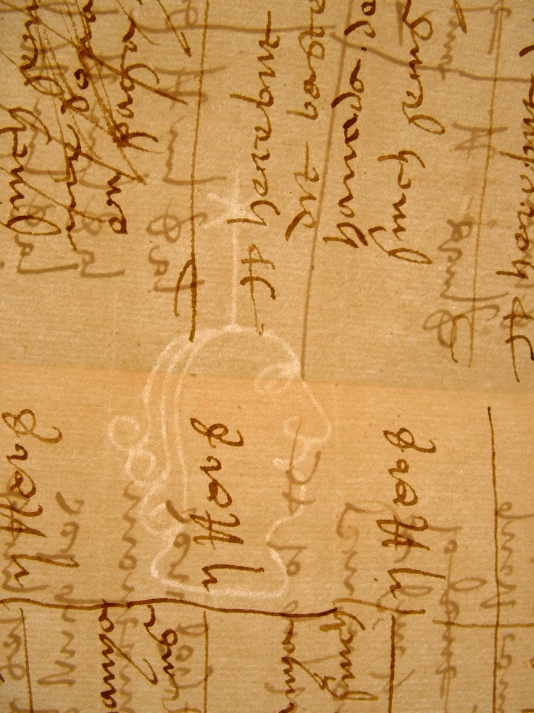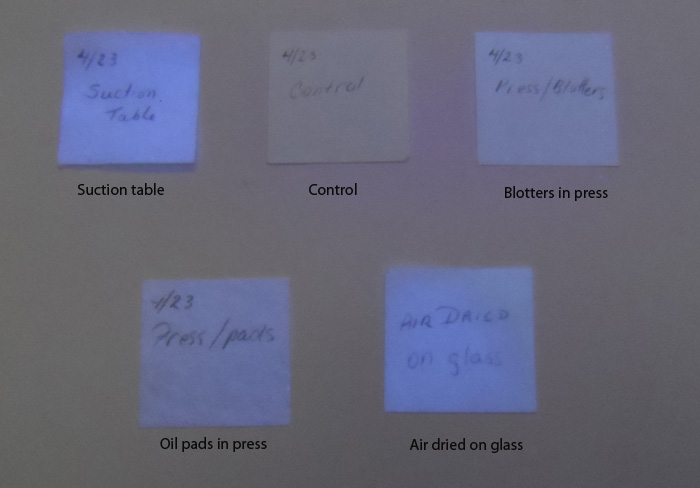 Karen L. Pavelka |
 |
| Home |
Portfolio |
Teaching |
About |
|
Oil absorbent
pads: An
addition to the disaster response toolkit |
In Spring, 2013, in a
class that explored disaster salvage techniques, one
experiment involved wetting materials with water
contaminated with motor oil. Salvaging
the objects from the oily environment proved to be
challenging; detergents were slow but effective and
required copious amounts of water. In a search
for alternative methods we found oil absorbent pads,
which absorb oil while repelling water. The pads are
fabricated of polypropylene fibers. A series of
tests was run to see how the materials might be used
during disaster salvage.
The experiments described below are preliminary
and not quantified. |
|
Experiment 1: Chromatography
paper in water contaminated with oil Objective: In the class
experiment when paper was removed from oily water the
result was heavily stained paper and oil spreading to
other materials.
The objective here was to try to contain the
oil and reduce the staining on paper. The
information reported is an amalgam of several
experiments. Vessels were filled with water and
a film of motor oil was floated on the surface. Small
squares of chromatography paper were placed on top of
the oil and eventually sank to the bottom of the
vessel. At
that point small squares of oil absorbent pads were
placed on top of the water. As the pads
became saturated they were removed and replaced with
clean pads. |
| Beakers with water, paper and oil |
Saturated oil pads |
| Third oil pad to be inserted in dish |
|
Removing oil
from water The oil absorbent pads worked
remarkably well to attract and contain oil. They seem to
work most effectively when placed in contact with the
oil layer and allowed to attract the oil rather than
being manipulated across the surface. They work
slowly, but appear to remove all but a slight sheen,
visible as interference colors. The initial
attempt to remove that remaining trace of oil by
passing the water through a funnel fabricated of an
oil absorbent pad did not work because the
polypropylene repels water, so small dishes were lined
with the pads and the water was placed in the
depression and swirled occasionally. After a few
hours, the interference colors were no longer visible. The water
was then poured through a funnel lined with
chromatography paper. When
the chromatography paper dried, it was placed under UV
light, where a slight trace of oil may have been
visible. No
analysis was done other than visual, nasal and tactile
observations. |
| Interference colors in water |
Water in oil absorbent pad "funnel" |
|
Removing oil
from chromatography paper The paper squares were dried by
various methods, not all of which are reported here. Drying
methods included: ·
Between oil
absorbent pads in a press ·
Between oil
absorbent pads on the suction table ·
Between
blotters in a press ·
Air dried on
glass None of the drying methods were
completely satisfactory for removing oil from the
chromatography paper.
Drying on an oil absorbent pad on the suction
table proved about as effective as air drying the
sample on a piece of glass. Pressing
paper between either the oil absorbent pads or
blotters in a book press seemed to be the most
effective at reducing the amount of oil in the paper. The more
pressure that was applied, the more oil seemed to be
removed. There
was little observable difference between the oil
absorbent pads and blotter paper, although this was
not conclusive and seemed to vary with successive
attempts. |
 |
|
Dried chromatography paper viewed
under UV. The
control was washed in water; other samples are
labeled. |
|
Experiment 2: Book in
water with oil Objective: Removing
books from oil-contaminated water in the class
experiment had been extremely messy and difficult. The
objective of this experiment was to see if the oil
absorbent pads might simplify the process. A mixture of approximately 7 liters
of water and 50 ml of motor oil was poured over a book
in a tray and it and allowed to sit for two hours. |
| Water and oil poured over book |
Book soaking in oily water |
|
Oil absorbent pads were placed in
the bath where they began to soak up the oil. However, the
time required to allow the pads to work was
counter-productive to drying the book, so the pads
were dragged across the surface of the water in the
tray, removing a significant quantity of oil, and then
the book was removed from the bath and placed on
blotters to dry.
The oil absorbent pads were quite effective
when used to wipe oil from the dust jacket and this
working method did help contain the spread of the oil,
as opposed to the efforts in class where oily books
were dried on paper towels. The oil absorbent pads were useful
cleaning up the tray and sink and seemed more
effective than paper towels and sponges. To check
this impression pieces of glass and ceramic were
dipped in the oily water and then wiped clean with
paper towels and with the oil absorbent pads. The pads
seemed to leave the objects with slightly less of an
oil film. |
| Oil absorbent pads in bath and inside book | Book dried with pads and blotters |
|
Conclusion The oil absorbent pads may be
useful to have on hand for clean up after disasters. They are
very useful to remove oil floating on the surface of
water. While
they may not be significantly more effective than
blotter removing oil from paper, they seemed to be
more efficient removing oil from harder surfaces such
as the dust jacket, glass and ceramic, although some
grades will leave lint.
They are less messy to work with than paper
towels. They can be squeezed out while
working and the water is removed but the oil remains
captured, which was useful when cleaning up. They are
made of polypropylene with no additives so health
risks are minimal.
They are relatively inexpensive, especially if
bought in bulk. The
pads come in different grades, some very smooth and
some more fibrous.
The differences between various qualities of
the pads have not been investigated. No further
investigation is planned for these pads. Suppliers Oil absorbent pads are readily
available from industrial suppliers and easily found
using the search terms "oil absorbent pads." There are
many different suppliers, some of whom will send
samples. Credits My thanks to Rebecca Elder for
finding the oil absorbent pads and helping devise the
tests. |